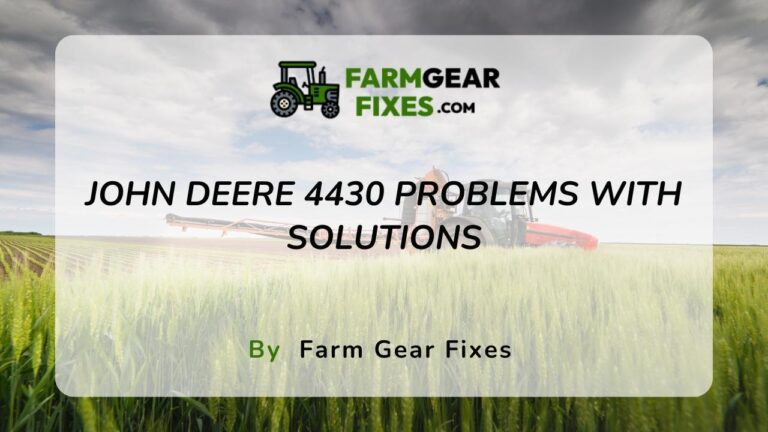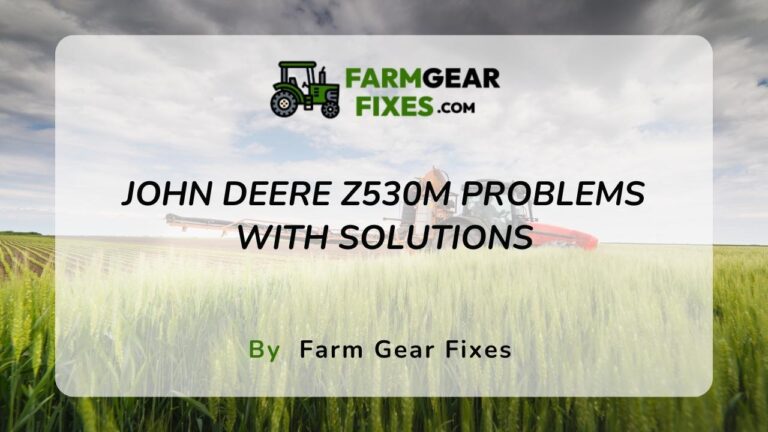6 Common John Deere 3025E Problems (Solutions Included)

The John Deere 3025e is a reliable and popular tractor, but like any piece of machinery, it is not immune to occasional issues. Whether you are experiencing transmission problems, hydraulic issues, or electrical malfunctions, this blog post will provide you with practical solutions to address and resolve these common problems.
By the time you finish reading, you’ll have a comprehensive understanding of how to troubleshoot and fix any issues that may arise with your John Deere 3025e, ensuring that your tractor stays in top working condition.
Common Mechanical Issues and Solutions
1) Engine Troubleshooting and Repairs
To ensure your John Deere 3025e runs smoothly, it’s important to regularly inspect and maintain the engine. Common issues such as overheating, loss of power, or strange noises can often be traced back to problems with the engine. If you notice any of these symptoms, it’s crucial to take action immediately to prevent further damage.
One common solution to these issues is to regularly check and replace the air filter, fuel filter, and oil filter. In addition, ensuring proper fuel and oil levels, and using high-quality fuel and oil, can also help alleviate engine problems. If these measures don’t resolve the issue, consulting a professional mechanic may be necessary to diagnose and repair any underlying mechanical issues.
To prevent future engine problems, it’s also important to follow the recommended maintenance schedule outlined in the John Deere 3025e manual. This includes regular oil changes, filter replacements, and overall inspections.
Additionally, paying attention to any unusual smells, vibrations, or changes in engine performance can help catch potential issues early on, preventing more serious damage down the road. By staying proactive with engine maintenance, you can ensure a longer and healthier lifespan for your John Deere 3025e.
2) Transmission and Drive Train Problems
With proper care and maintenance, the transmission and drive train of the John Deere 3025e should provide reliable and efficient performance. However, issues such as gear slipping, difficulty shifting, or strange noises can arise over time.
Any abnormal symptoms with the transmission or drive train should be addressed promptly to avoid more costly repairs down the line. A common solution to these problems is to regularly inspect and change the transmission fluid, as well as ensure the proper adjustment of the clutch. Additionally, checking for any leaks or worn components can help prevent more serious issues from developing.
It’s also essential to operate the vehicle within the specified limits of load and speed, as exceeding these limits can put unnecessary strain on the transmission and drive train. By adhering to the manufacturer’s guidelines and addressing any issues as soon as they arise, you can maintain the reliability and performance of the transmission and drive train, prolonging the lifespan of your John Deere 3025e.
Electrical System Complications
An efficient electrical system is crucial for the smooth operation of a John Deere 3025e. However, like any other equipment, this tractor may experience electrical problems that can hinder its performance. Understanding these issues and their solutions is essential for maintaining the functionality of the electrical system.
3) Starting and Charging Issues
Electrical starting and charging problems are common issues with the John Deere 3025e. These problems can arise due to a faulty starter, alternator, or battery. To resolve starting issues, it is important to perform regular maintenance on the battery, connections, and charging system. Additionally, checking the wiring and fuses for any signs of damage can help prevent future starting and charging complications.
4) Instrument Panel and Sensor Failures
The instrument panel and sensor failures can disrupt the proper functioning of the electrical system in the John Deere 3025e. The failure of sensors or malfunctioning of the instrument panel can lead to inaccurate readings and overall performance issues.
Regular inspection and cleaning of the sensors, as well as proper calibration of the instrument panel, can help mitigate these failures. It is important to address any warning lights or error messages promptly to prevent further damage to the electrical system.
Starting with the electrical system is crucial in troubleshooting instrument panel and sensor failures. Checking the connections, wiring, and sensors for any loose or damaged components is key to diagnosing and resolving these issues. Regular maintenance and prompt attention to any warning signs can prevent instrument panel and sensor failures in the John Deere 3025e.
Hydraulic and PTO Concerns
For John Deere 3025E owners, hydraulic and power take-off (PTO) concerns are a common and frustrating issue. These problems can lead to downtime and decreased productivity. Fortunately, there are solutions to address these issues and get your equipment back up and running efficiently.
5) Hydraulic System Leaks and Pressure Loss
For some John Deere 3025E owners, hydraulic system leaks and pressure loss can be a recurring problem. Leaks can develop in the hoses, fittings, or seals, leading to a loss of hydraulic fluid and a decrease in pressure. This can result in slower operation and reduced power for attached implements.
To address this issue, it’s important to regularly inspect and maintain the hydraulic system. This includes checking for leaks, replacing worn or damaged components, and ensuring proper fluid levels and cleanliness. Additionally, using high-quality hydraulic fluid and filters can help prevent leaks and pressure loss.
6) Power Take-Off (PTO) Malfunctions
The power take-off (PTO) on the John Deere 3025E is essential for powering implements such as mowers and rotary tillers. However, some owners may experience malfunctions with the PTO, including engagement issues, uneven power distribution, or complete failure.
The PTO system relies on a combination of mechanical and hydraulic components, and problems can arise from wear and tear, improper adjustments, or lack of lubrication. To address PTO malfunctions, it’s crucial to perform regular maintenance, including greasing PTO components, adjusting PTO clutch settings, and checking for any worn or damaged parts.
Additionally, following proper operating procedures and avoiding excessive loads on the PTO can help prevent malfunctions.
System malfunctions of the PTO can result in costly downtime and the inability to effectively operate attachments. Regular maintenance and proper operation are key to preventing PTO issues and ensuring reliable performance of the John Deere 3025E.
Maintenance and Operational Best Practices
Keep your John Deere 3025e running smoothly and efficiently by following these maintenance and operational best practices. By implementing these recommendations, you can minimize potential problems and maximize the performance of your tractor.
Routine Service Recommendations
To ensure the longevity and optimal performance of your John Deere 3025e, it is crucial to adhere to routine service recommendations. This includes regular oil changes, filter replacements, and fluid inspections. By staying vigilant with routine maintenance, you can prevent major issues from arising and keep your tractor in top condition for years to come.
Conclusion
Maintenance plays a critical role in optimizing your tractor’s performance. Keep an eye on tire pressure, check for any loose bolts or parts, and clean the tractor regularly to prevent the buildup of debris. Additionally, using the appropriate fuel and lubricants recommended by John Deere can ensure that your tractor runs efficiently and smoothly. Recognizing any unusual noises or vibrations and addressing them promptly can also prevent potential problems from escalating.
- Regular oil changes
- Filter replacements
- Fluid inspections
For instance, checking tire pressure regularly can prevent unnecessary wear and tear on your tractor’s tires, ultimately improving its overall performance and reducing the likelihood of tire-related issues. By staying proactive and attentive to maintenance and operational best practices, you can keep your John Deere 3025e in optimal working condition.






